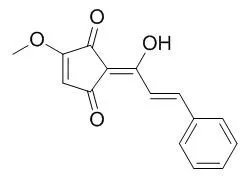| Kinase Assay: |
| Food Chem Toxicol. 2013 Sep;59:55-66. | | Lucidone protects human skin keratinocytes against free radical-induced oxidative damage and inflammation through the up-regulation of HO-1/Nrf2 antioxidant genes and down-regulation of NF-κB signaling pathway.[Pubmed: 23712098] | We investigated the protective effects of Lucidone, a naturally occurring cyclopentenedione isolated from the fruits of Lindera erythrocarpa Makino, against free-radical and inflammation stimulator 2,2'-azobis (2-amidinopropane) dihydrochloride (AAPH)-induced oxidative stress in human keratinocyte (HaCaT) cells, with the aim of revealing the possible mechanisms underlying the protective efficacy.
METHODS AND RESULTS:
Lucidone pretreatment (0.5-10 μg/mL) markedly increased HaCaT cell viability and suppressed AAPH-induced reactive oxygen species (ROS) generation, lipid peroxidation, and DNA damage. Notably, the antioxidant potential of Lucidone was directly correlated with the increased expression of an antioxidant gene, heme oxygenase 1 (HO-1), which was followed by the augmentation of the nuclear translocation and transcriptional activation of NF-E2-related factor-2 (Nrf2), with or without AAPH. Nrf2 knockdown diminished the protective effects of Lucidone. We also observed that Lucidone pretreatment inhibited AAPH-induced inflammatory chemokine prostaglandin E₂ (PGE₂) production and the expression of cyclooxygenase-2 (COX-2) in HaCaT cells. Lucidone treatment also significantly inhibited AAPH-induced nuclear factor-κB (NF-κB) activation and suppressing the degradation of inhibitor-κB (I-κB). Furthermore, Lucidone significantly diminished AAPH-induced COX-2 expression through the down-regulation of the extracellular signal-regulated kinase (ERK) and p38 MAPK signaling pathways.
CONCLUSIONS:
Therefore, Lucidone may possess antioxidant and anti-inflammatory properties and may be useful for the prevention of free radical-induced skin damage. | | Biochim Biophys Acta. 2017 Jan;1864(1):151-168. | | Lucidone Promotes the Cutaneous Wound Healing Process via Activation of the PI3K/AKT, Wnt/β-catenin and NF-κB Signaling Pathways.[Pubmed: 27816443 ] | Lucidone, which comprises a naturally occurring cyclopentenedione, has been investigated for its in vitro and in vivo wound healing properties, and the underlying molecular signaling cascades in the wound healing mechanism have been elucidated.
METHODS AND RESULTS:
We demonstrated the cell-/dose-specific responses of Lucidone (0.5-8μM) on proliferation and migration/invasion of keratinocyte HaCaT and fibroblast Hs68 cells. In keratinocytes, Lucidone-induced nuclear translocation of β-catenin was accompanied by increased transcriptional target genes, including c-Myc and cyclin-D1, through GSK3β-dependent pathway. Correspondingly, Lucidone promoted the cell-cycle by increasing PCNA/CDK4 and decreasing p21/p27 expressions. Lucidone induced EMT through the downregulation of epithelial (E-cadherin/occludin) and upregulation of mesenchymal (vimentin/Twist/Snail) marker proteins. Activated MMP-9/-2 and uPA/uPAR as well as suppressed TIMP-1/-2 and PAI-1 expressions by Lucidone may promote the migration/invasion of keratinocytes. Notably, Lucidone activated NF-κB signaling via IKK-mediated-IκB degradation, and its inhibition abolished MMP-9 activation and keratinocyte migration. Inhibition of PI3K/AKT signaling impaired the Lucidone-induced proliferation/migration with corresponding suppression of β-catenin/c-Myc/cyclin-D1 and NF-κB/MMP-9 expressions. Results indicate that Lucidone-induced PI3K/AKT signaling anchored the β-catenin/NF-κB-mediated healing mechanism. β-catenin knockdown substantially diminished Lucidone-induced keratinocyte migration. Furthermore, Lucidone increased endothelial cell proliferation/migration and triggered angiogenesis (MMP-9/uPA/ICAM-1). In macrophages, Lucidone-activated NF-κB-mediated inflammation (COX-2/iNOS/NO) and VEGF, which may contribute to the growth of keratinocytes/fibroblasts and endothelial cells. Punched wounds on mice were rapidly healed with the topical application of Lucidone (5mM) compared with control ointment-treated mice.
CONCLUSIONS:
Taken together, Lucidone accelerates wound healing through the cooperation of keratinocyte/fibroblast/endothelial cell growth and migration and macrophage inflammation via PI3K/AKT, Wnt/β-catenin and NF-κB signaling cascade activation. |
|
| Animal Research: |
| Phytomedicine. 2013 Mar 15;20(5):394-400. | | Lucidone from Lindera erythrocarpa Makino fruits suppresses adipogenesis in 3T3-L1 cells and attenuates obesity and consequent metabolic disorders in high-fat diet C57BL/6 mice.[Pubmed: 23265843] | Obesity is associated with an increased risk of development of numerous diseases including type 2 diabetes, hypertension, hyperlipidemia, and cardiovascular disease.
METHODS AND RESULTS:
In this study, we investigated the effects of Lucidone in vitro on gene expression during adipogenesis in 3T3-L1 cells and in vivo on high-fat diet induced obesity in C57BL/6 mice. Lucidone at 40 μmol/L suppressed adipogenesis in 3T3-L1 cells by reducing transcription levels of adipogenic genes, including PPARγ, C/EBPα, LXR-α, LPL, aP2, GLUT4 and adiponectin. Five-week-old male C57BL/6 mice fed a high fat diet (60% energy from fat) supplemented with Lucidone at a dosage of 1250 mg/kg of diet for 12 weeks had reduced body and liver weight, reduced epididymal and perirenal adipose tissue, decreased food efficiency (percentage of weight gain divided by food intake), and lowered plasma cholesterol, triglyceride, glucose, and insulin levels. Dissection of adipose tissue from Lucidone-treated mice showed a reduction in the average fat-cell size and percentage of large adipocytes.
CONCLUSIONS:
These results provide evidence that dietary intake of Lucidone alleviates high fat diet-induced obesity in C57BL/6 mice and reveals the potential of Lucidone as a nutraceutical to prevent obesity and consequent metabolic disorders. |
|






 Cell. 2018 Jan 11;172(1-2):249-261.e12. doi: 10.1016/j.cell.2017.12.019.IF=36.216(2019)
Cell. 2018 Jan 11;172(1-2):249-261.e12. doi: 10.1016/j.cell.2017.12.019.IF=36.216(2019) Cell Metab. 2020 Mar 3;31(3):534-548.e5. doi: 10.1016/j.cmet.2020.01.002.IF=22.415(2019)
Cell Metab. 2020 Mar 3;31(3):534-548.e5. doi: 10.1016/j.cmet.2020.01.002.IF=22.415(2019) Mol Cell. 2017 Nov 16;68(4):673-685.e6. doi: 10.1016/j.molcel.2017.10.022.IF=14.548(2019)
Mol Cell. 2017 Nov 16;68(4):673-685.e6. doi: 10.1016/j.molcel.2017.10.022.IF=14.548(2019)